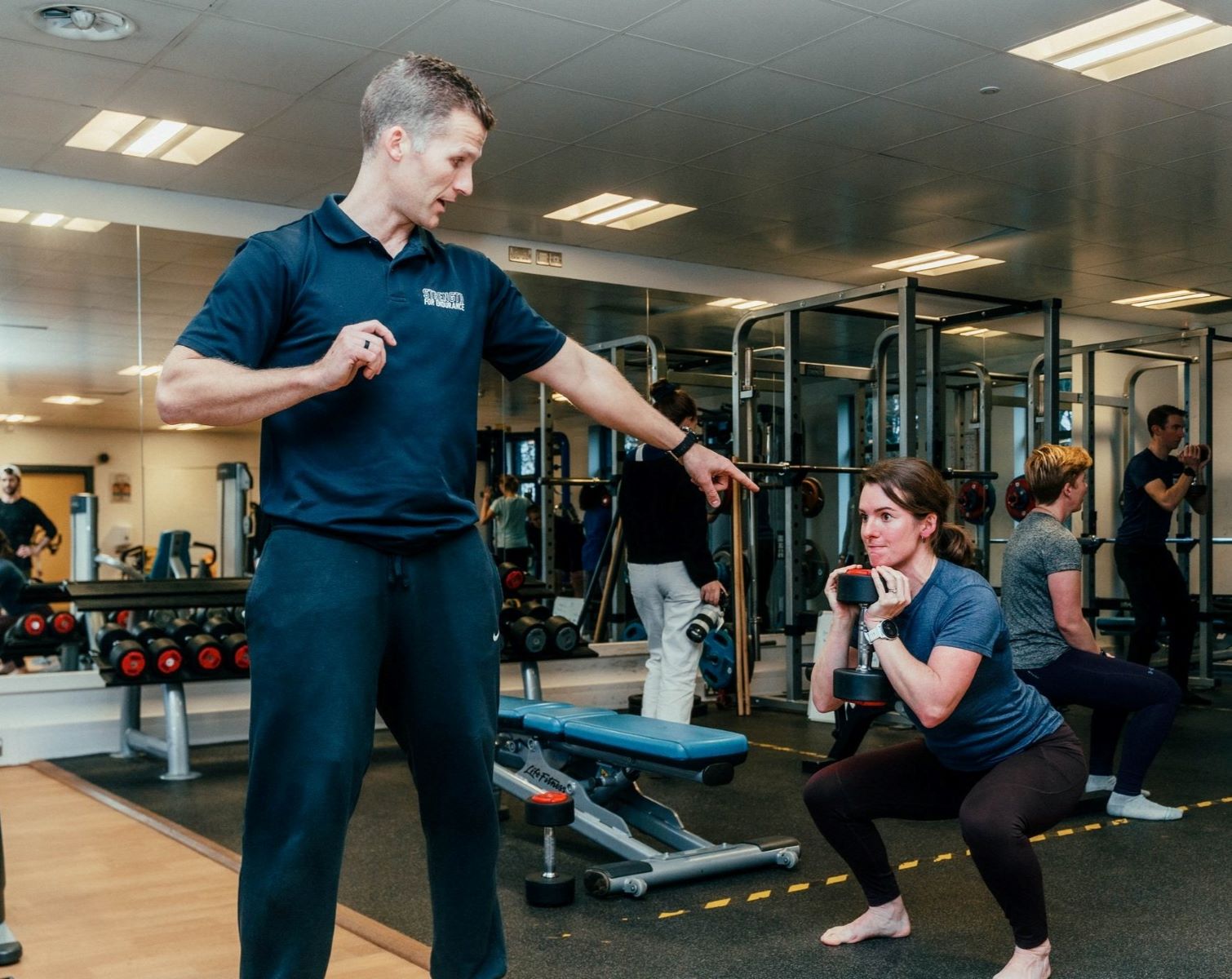Home>Misc>Featured>How Does Aerobic Capacity Relate To Cardiorespiratory Endurance?


Featured
How Does Aerobic Capacity Relate To Cardiorespiratory Endurance?
Modified: October 24, 2023
Learn and understand the meaning of aerobic capacity and its connection to cardiorespiratory endurance in this featured article.
Introduction
Welcome to the fascinating world of aerobic capacity and cardiorespiratory endurance! These terms may sound complex, but they play a crucial role in your overall fitness and well-being. Whether you’re an avid athlete or just starting your fitness journey, understanding these concepts is key to optimizing your exercise routine and achieving your goals.
Aerobic capacity, also known as aerobic fitness or cardiorespiratory fitness, refers to your body’s ability to take in, transport, and utilize oxygen during physical activity. It is a measure of how well your cardiovascular and respiratory systems work together to supply the necessary oxygen to your muscles. In simpler terms, it reflects your body’s efficiency in producing energy through aerobic metabolism.
On the other hand, cardiorespiratory endurance refers to the duration and intensity at which you can perform aerobic activities without becoming fatigued. It is a measure of your stamina and the ability to sustain prolonged physical activity. Think of it as the “gas tank” of your body – the higher your cardiorespiratory endurance, the longer you can go before feeling tired.
Understanding the relationship between aerobic capacity and cardiorespiratory endurance is essential. Aerobic capacity sets the foundation for cardiorespiratory endurance, as it determines the maximum amount of oxygen your body can utilize during exercise. The higher your aerobic capacity, the more efficient your body becomes at delivering oxygen to your muscles, allowing you to perform for longer periods without fatigue.
Moreover, individuals with higher aerobic capacity often experience improved overall health and reduced risk of chronic diseases such as cardiovascular disease, diabetes, and obesity. Regular aerobic exercise, along with maintaining optimal aerobic capacity, is crucial for maintaining a healthy weight, managing stress levels, and enhancing mental well-being.
Factors such as genetics, age, gender, and training status can influence your aerobic capacity. However, the good news is that aerobic capacity is not fixed and can be improved through various training methods and lifestyle modifications.
In this article, we will delve deeper into the intricacies of aerobic capacity and cardiorespiratory endurance. We will explore the factors that affect aerobic capacity and discuss effective methods to enhance both your aerobic capacity and cardiorespiratory endurance. So, tighten your shoelaces, take a deep breath, and let’s embark on this fitness journey together!
What is Aerobic Capacity?
Aerobic capacity, also referred to as aerobic fitness or cardiorespiratory fitness, is a measure of your body’s ability to take in, transport, and utilize oxygen during physical activity. It involves the efficient functioning of your cardiovascular and respiratory systems in delivering oxygen to your working muscles. Essentially, it reflects how well your body can generate energy through aerobic metabolism.
To understand aerobic capacity better, let’s break down the process. During aerobic activities such as running, cycling, or swimming, your body relies on oxygen to break down carbohydrates and fats to produce energy. The more efficiently this process occurs, the higher your aerobic capacity.
Aerobic capacity is commonly expressed as the maximum volume of oxygen that your body can use per kilogram of body weight per minute, known as VO2 max. This measurement indicates the maximum amount of oxygen your muscles can utilize during intense exercise. The higher your VO2 max, the greater your aerobic capacity.
Aerobic capacity plays a vital role in various aspects of your fitness and overall health. It affects your endurance level, allowing you to sustain physical activity for longer durations without feeling fatigued. Moreover, individuals with higher aerobic capacity are more likely to excel in endurance-based sports such as long-distance running or cycling.
Furthermore, aerobic capacity has significant implications for overall health and disease prevention. Studies have shown that individuals with higher aerobic capacity have a lower risk of developing chronic conditions such as cardiovascular disease, diabetes, and obesity. Regular aerobic exercise, which enhances your aerobic capacity, is an essential component of a healthy lifestyle.
It’s important to note that aerobic capacity is influenced by various factors. While genetics, age, and gender can play a role, your lifestyle habits also significantly impact your aerobic fitness. Regular aerobic exercise, maintaining a healthy body weight, and avoiding smoking are all factors that can positively influence your aerobic capacity.
In summary, aerobic capacity refers to your body’s ability to efficiently use oxygen during physical activity. It is a key determinant of your endurance and overall fitness level. By improving your aerobic capacity, you can enhance your performance in endurance activities, reduce the risk of chronic diseases, and improve your overall health and well-being.
Understanding Cardiorespiratory Endurance
Cardiorespiratory endurance is a term used to describe the ability of your cardiovascular and respiratory systems to supply oxygen and nutrients to your working muscles during sustained physical activity. It refers to your body’s capacity to perform aerobic exercises at a moderate to high intensity for extended periods without experiencing excessive fatigue.
Cardiorespiratory endurance goes beyond the concept of aerobic capacity by considering the duration and intensity of activity. It focuses on how efficiently your body can sustain physical effort over a prolonged period, without feeling exhausted or out of breath.
During aerobic exercise, your heart pumps oxygenated blood to your muscles, supplying them with the oxygen they need to produce energy. Simultaneously, your respiratory system helps facilitate the exchange of oxygen and carbon dioxide, ensuring a continuous supply of oxygen to the bloodstream and the removal of metabolic waste products.
Individuals with good cardiorespiratory endurance have the ability to perform activities such as running, swimming, or cycling for a longer duration at a higher intensity. They experience less fatigue, as their cardiovascular and respiratory systems efficiently deliver oxygen to their muscles, allowing them to sustain physical effort for extended periods.
Cardiorespiratory endurance plays a crucial role in overall physical fitness. It is beneficial for daily activities, sports performance, and maintaining a healthy body weight. By improving cardiorespiratory endurance, you can increase your stamina, reduce the risk of fatigue and injuries, and enhance your overall quality of life.
Improving cardiorespiratory endurance involves consistent, aerobic exercises that challenge your heart and lungs. Activities like jogging, swimming, cycling, or brisk walking can all help improve your endurance levels. It’s important to gradually increase the intensity and duration of your workouts to allow your body to adapt and progress.
In addition to aerobic exercise, incorporating other forms of training like interval training and strength training can also improve your cardiorespiratory endurance. Interval training involves alternating between high-intensity exercises and periods of rest or lower intensity. This type of training can help enhance your cardiovascular fitness and increase your tolerance to higher intensity activities.
Overall, understanding cardiorespiratory endurance allows you to gauge your fitness level and develop strategies to improve your endurance. By engaging in regular aerobic exercise and incorporating other training methods, you can enhance your body’s ability to sustain physical activity, increase your stamina, and improve your overall fitness.
The Relationship Between Aerobic Capacity and Cardiorespiratory Endurance
Aerobic capacity and cardiorespiratory endurance are closely interconnected and play pivotal roles in your fitness and overall health. While aerobic capacity focuses on your body’s ability to utilize oxygen during exercise, cardiorespiratory endurance encompasses the duration and intensity at which you can sustain physical activity. Understanding the relationship between these two concepts is essential for optimizing your training and achieving your fitness goals.
Aerobic capacity forms the foundation for cardiorespiratory endurance. It determines the maximum amount of oxygen your body can use during exercise, reflecting your body’s efficiency in delivering oxygen to your muscles. The higher your aerobic capacity, the more efficiently your body can produce energy through aerobic metabolism. This, in turn, allows you to sustain physical activity for longer periods without fatigue.
Cardiorespiratory endurance, on the other hand, depends on your aerobic capacity. It involves the ability to perform aerobic exercises at a moderate to high intensity for extended durations. Individuals with higher aerobic capacity tend to have better cardiorespiratory endurance as their cardiovascular and respiratory systems are better equipped to meet the demands of sustained physical effort.
Improving your aerobic capacity can lead to improvements in your cardiorespiratory endurance. As you engage in regular aerobic exercise and increase your aerobic capacity, your body becomes more efficient at delivering oxygen to your working muscles. This allows you to sustain physical activity for longer durations at higher intensities without experiencing excessive fatigue.
Similarly, enhancing your cardiorespiratory endurance can positively impact your aerobic capacity. By challenging your cardiovascular and respiratory systems through prolonged and intense aerobic exercise, you stimulate adaptations that improve your body’s ability to utilize oxygen. This leads to an increase in your aerobic capacity over time.
It’s important to note that both aerobic capacity and cardiorespiratory endurance are adaptable and can be improved through consistent training. Engaging in a variety of aerobic exercises, such as running, cycling, swimming, or using cardio machines, can help stimulate adaptations in both your aerobic capacity and cardiorespiratory endurance.
Incorporating interval training, which involves alternating intensities during your workouts, can further enhance both components. High-intensity intervals challenge your body’s limits, pushing your aerobic capacity, while the recovery intervals allow your body to adapt and recover, improving your endurance.
To optimize your training, it’s essential to strike a balance between improving your aerobic capacity and developing your cardiorespiratory endurance. By gradually increasing the intensity and duration of your workouts, you can challenge your body and stimulate these adaptations. Additionally, incorporating variety in your training routine and monitoring your progress can help keep you motivated and ensure continued improvements in both aspects.
In summary, aerobic capacity and cardiorespiratory endurance are closely intertwined, with aerobic capacity serving as the foundation for cardiorespiratory endurance. By improving both components through regular aerobic exercise and incorporating other training methods, you can enhance your body’s efficiency in utilizing oxygen, sustain physical activity for longer durations, and achieve optimal fitness levels.
Factors Affecting Aerobic Capacity
Aerobic capacity, or aerobic fitness, is influenced by various factors that can either enhance or impair your body’s ability to utilize oxygen during exercise. Understanding these factors can help you identify areas to focus on when aiming to improve your aerobic capacity. Let’s explore some of the key factors that can impact your aerobic fitness.
Genetics: Your genetic makeup plays a role in determining your aerobic capacity. Some individuals may naturally have a higher aerobic capacity due to genetic factors, such as a higher number of mitochondria (the powerhouse of cells) or a higher concentration of oxygen-carrying proteins. However, genetics is not the sole determinant, and aerobic capacity can still be improved through training and lifestyle modifications.
Age: Aerobic capacity tends to peak during young adulthood and gradually declines with age. As you get older, your body’s ability to deliver and utilize oxygen may decrease, leading to a reduction in aerobic capacity. However, regular exercise can help slow down the age-related decline and improve aerobic fitness, regardless of age.
Gender: On average, males tend to have a higher aerobic capacity compared to females due to physiological differences. Men typically have a higher percentage of muscle mass and a larger lung volume, both of which contribute to higher oxygen transport and utilization. However, it’s important to note that individual variations exist, and women can still achieve significant improvements in aerobic capacity through proper training.
Training Status: Your current level of fitness and training experience greatly affect your aerobic capacity. Individuals who engage in regular aerobic exercise, such as endurance training or cardiovascular activities, tend to have higher aerobic capacities. The body adapts to the demands placed upon it, and by consistently challenging your cardiovascular and respiratory systems through training, you can enhance your aerobic capacity.
Body Composition: Your body composition, specifically the ratio of lean muscle mass to body fat, can impact your aerobic capacity. Higher levels of lean muscle mass are associated with a higher aerobic capacity. Muscle tissue has a higher metabolic demand than fat tissue, requiring more oxygen for energy production. Maintaining a healthy body composition through a combination of regular exercise and a balanced diet can support optimal aerobic capacity.
Altitude: The altitude at which you live or train can affect your aerobic capacity. At higher altitudes, the air is thinner, meaning there is less oxygen available for your body. This can initially decrease your aerobic capacity. However, over time, your body can adapt to altitude training by producing more red blood cells to enhance oxygen-carrying capacity. This adaptation can improve your aerobic capacity, which is why some athletes train at high altitudes to gain a competitive edge.
Overall Health: Your overall health and the presence of certain medical conditions can impact your aerobic capacity. Chronic diseases, such as cardiovascular disease or respiratory disorders, can diminish aerobic fitness. Additionally, lifestyle factors such as smoking, poor nutrition, and obesity can also impair your body’s ability to utilize oxygen efficiently. Managing these health conditions and adopting a healthy lifestyle can help improve your aerobic capacity.
While these factors influence your aerobic capacity, it’s important to remember that your potential for improvement is not limited by them. Through regular aerobic exercise, proper training, and adopting a healthy lifestyle, you can enhance your aerobic capacity, regardless of your genetic predispositions or other influencing factors.
Methods to Improve Aerobic Capacity and Cardiorespiratory Endurance
Improving your aerobic capacity and cardiorespiratory endurance requires consistent effort and a well-rounded approach to your training. By incorporating various methods, you can enhance your body’s ability to utilize oxygen and sustain physical activity for longer durations. Let’s explore some effective strategies to improve your aerobic capacity and cardiorespiratory endurance.
Aerobic Exercise: Engaging in regular aerobic exercise is key to improving your aerobic capacity and endurance. Focus on activities that elevate your heart rate and challenge your cardiovascular and respiratory systems. Running, swimming, cycling, rowing, and using cardio machines like treadmills or ellipticals are excellent choices. Aim for a minimum of 150 minutes of moderate-intensity aerobic exercise or 75 minutes of vigorous-intensity aerobic exercise each week.
Interval Training: Incorporating interval training can help boost your aerobic capacity and endurance. This training method involves alternating between high-intensity bursts and periods of active recovery or lower intensity. For example, during a run, you can alternate between short sprints and slower jogs. This type of training challenges your body to adapt to varying intensities, improving your overall fitness level.
Long Slow Distance (LSD) Training: Including longer duration, lower intensity workouts in your training routine can enhance your endurance capabilities. LSD training involves performing aerobic exercises at a comfortable pace for an extended period. It allows your body to adapt to sustained effort, improving your cardiorespiratory endurance. Consider incorporating a long run, bike ride, or swim into your training schedule once a week.
Cross-Training: Incorporating cross-training activities into your workout routine can help improve your aerobic capacity while reducing the risk of overuse injuries. Engage in activities such as strength training, yoga, Pilates, or low-impact exercises like swimming or cycling. Cross-training not only works different muscle groups but also provides variety to keep you motivated and prevent workout plateaus.
Gradual Progression: Gradually increasing the intensity and duration of your workouts is important to avoid overexertion and minimize the risk of injury. Start with a comfortable level and progressively challenge yourself over time. This gradual progression allows your body to adapt and improve your aerobic capacity and endurance without placing excessive stress on your cardiovascular system.
Recovery and Rest: Rest and recovery play a crucial role in improving your aerobic capacity and endurance. Allow your body sufficient time to recover and repair between workouts. While challenging yourself is important, avoid overtraining, which can lead to fatigue, decreased performance, and increased injury risk. Incorporating rest days and incorporating active recovery activities like stretching or yoga can help optimize your training results.
Proper Nutrition and Hydration: Fueling your body with adequate nutrition and maintaining proper hydration is vital for improving aerobic capacity and endurance. Consume a balanced diet that includes carbohydrates, proteins, and healthy fats to provide your body with the necessary fuel for exercise. Stay hydrated before, during, and after workouts to optimize performance and recovery.
Consistency: Consistency is key when it comes to improving aerobic capacity and endurance. Aim for regular exercise sessions throughout the week, and make them a priority in your routine. By maintaining consistency, you allow your body to adapt and make lasting improvements in your fitness level.
Incorporating these methods into your training routine can lead to significant improvements in your aerobic capacity and cardiorespiratory endurance. Remember, everyone is different, and it’s important to listen to your body, adapt your training to your fitness level, and seek guidance from a qualified fitness professional if needed. With dedication, patience, and the right approach, you can enhance your aerobic fitness and unlock your full potential for endurance activities.
Conclusion
Aerobic capacity and cardiorespiratory endurance are vital components of overall fitness and well-being. Aerobic capacity reflects your body’s ability to utilize oxygen during exercise, while cardiorespiratory endurance focuses on sustaining physical activity for extended durations. Understanding the relationship between these two concepts and implementing strategies to improve them can greatly enhance your fitness level and overall health.
Factors such as genetics, age, gender, and training status can influence your aerobic capacity, but they do not limit your potential for improvement. Through regular aerobic exercise, proper training, and adopting a healthy lifestyle, you can enhance your body’s ability to utilize oxygen and sustain physical activity for longer periods.
Effective methods to improve aerobic capacity and cardiorespiratory endurance include engaging in aerobic exercises, incorporating interval training and long slow distance training, cross-training, and ensuring proper rest and recovery. Gradual progression, proper nutrition, and consistency in your training routine are also keys to success.
By improving your aerobic capacity and cardiorespiratory endurance, you can experience a range of benefits. You’ll have increased stamina, reduced risk of chronic diseases, enhanced overall health and well-being, and improved performance in endurance activities.
Remember, it’s essential to personalize your training approach based on your fitness level, goals, and any individual considerations. Seek guidance from fitness professionals if needed and listen to your body to avoid overexertion and minimize the risk of injury.
So, lace up your shoes, dive into a new workout routine, and embark on the journey to enhance your aerobic capacity and cardiorespiratory endurance. With dedication, consistency, and a focus on steady progress, you’ll achieve new levels of fitness and uncover your full potential for endurance activities.









